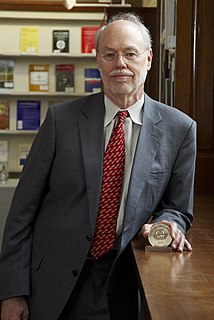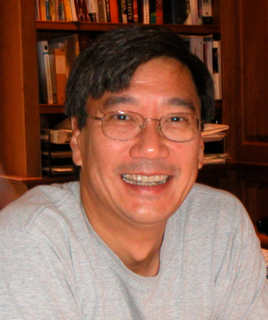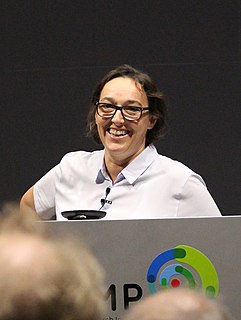Related Research Articles

David Baltimore is an American biologist, university administrator, and 1975 Nobel laureate in Physiology or Medicine. He is currently President Emeritus and Distinguished Professor of Biology at the California Institute of Technology (Caltech), where he served as president from 1997 to 2006. He also served as the director of the Joint Center for Translational Medicine, which joined Caltech and UCLA in a program to translate basic scientific discoveries into clinical realities. He also formerly served as president of Rockefeller University from 1990 to 1991, founder and Director of the Whitehead Institute of Biomedical Research from 1982 to 1990, and was president of the American Association for the Advancement of Science in 2007.

Salvador Edward Luria was an Italian microbiologist, later a naturalized U.S. citizen. He won the Nobel Prize in Physiology or Medicine in 1969, with Max Delbrück and Alfred Hershey, for their discoveries on the replication mechanism and the genetic structure of viruses. Salvador Luria also showed that bacterial resistance to viruses (phages) is genetically inherited.

Howard Robert Horvitz is an American biologist best known for his research on the nematode worm Caenorhabditis elegans, for which he was awarded the 2002 Nobel Prize in Physiology or Medicine, together with Sydney Brenner and John E. Sulston, whose "seminal discoveries concerning the genetic regulation of organ development and programmed cell death" were "important for medical research and have shed new light on the pathogenesis of many diseases".

Phillip Allen Sharp is an American geneticist and molecular biologist who co-discovered RNA splicing. He shared the 1993 Nobel Prize in Physiology or Medicine with Richard J. Roberts for "the discovery that genes in eukaryotes are not contiguous strings but contain introns, and that the splicing of messenger RNA to delete those introns can occur in different ways, yielding different proteins from the same DNA sequence". He has been selected to receive the 2015 Othmer Gold Medal.
John Machlin Buchanan was an American professor of biochemistry at the Massachusetts Institute of Technology. He arrived at MIT in 1953 and retired in 1988 after a distinguished career in which he was elected a fellow of the American Academy of Arts and Sciences and the National Academy of Sciences. He played a key role in the development of MIT's Department of Biology as a major force in biochemistry research and was himself a prominent researcher of purine biosynthesis. He died in 2007 at age 89.

Peter S. Kim is an American scientist. He was president of Merck Research Laboratories (MRL) 2003-2013 and is currently Virginia & D.K. Ludwig Professor of Biochemistry at Stanford University, Institute Scholar at Stanford ChEM-H, and Lead Investigator of the Infectious Disease Initiative at the Chan Zuckerberg Biohub.
Thomas Dean Pollard is a prominent educator, cell biologist and biophysicist whose research focuses on understanding cell motility through the study of actin filaments and myosin motors. He is Sterling Professor of Molecular, Cellular & Developmental Biology and a Professor of Cell Biology and Molecular Biophysics & Biochemistry at Yale University. He was Dean of Yale's Graduate School of Arts and Sciences from 2010 to 2014, and President of the Salk Institute for Biological Studies from 1996 to 2001.

Angelika Amon was an Austrian American molecular and cell biologist, and the Kathleen and Curtis Marble Professor in Cancer Research at the Massachusetts Institute of Technology (MIT) in Cambridge, Massachusetts, United States. Amon's research centered on how chromosomes are regulated, duplicated, and partitioned in the cell cycle. Amon was elected to the American Academy of Arts and Sciences in 2017.
Harvey F. Lodish is a molecular and cell biologist, professor at the Massachusetts Institute of Technology (MIT), Founding Member of the Whitehead Institute for Biomedical Research, and lead author of the textbook Molecular Cell Biology. Lodish's research focuses on cell surface proteins and other important areas at the interface between molecular cell biology and medicine.
Laura Lee Kiessling is an American chemist and the Novartis Professor of Chemistry at the Massachusetts Institute of Technology. Kiessling's research focuses on elucidating and exploiting interactions on the cell surface, especially those mediated by proteins binding to carbohydrates. Multivalent protein-carbohydrate interactions play roles in cell-cell recognition and signal transduction. Understanding and manipulating these interactions provides tools to study biological processes and design therapeutic treatments. Kiessling's interdisciplinary research combines organic synthesis, polymer chemistry, structural biology, and molecular and cell biology.
David A. Tirrell is an American chemist and the Ross McCollum-William H. Corcoran Professor and Professor of Chemistry and Chemical Engineering at the California Institute of Technology (Caltech). A pioneer in the areas of polymer synthesis and protein biosynthesis, his research has a wide range of applications, including coatings, adhesion, lubrication, bioengineering and biomedical intervention. From 2012 to 2018, Tirrell was the Director of the Beckman Institute at Caltech. As of 2017, he serves as Caltech's Provost. He is one of very few American scientists to have been elected to all three branches of the United States National Academies: the National Academy of Science (2006), the National Academy of Engineering (2008), and the Institute of Medicine (2011). He was elected a Member of the American Philosophical Society in 2019.
Gordon G. Hammes is a distinguished service professor of biochemistry, emeritus, at Duke University, professor emeritus at Cornell University, and member of United States National Academy of Sciences. Hammes' research involves the study of enzyme mechanisms and enzyme regulation.

Bonnie Anne Berger is an American mathematician and computer scientist, who works as the Simons professor of mathematics and professor of electrical engineering and computer science at the Massachusetts Institute of Technology. Her research interests are in algorithms, bioinformatics and computational molecular biology.
Mary-Lou Pardue is an American geneticist who is an emeritus professor in the Department of Biology at the Massachusetts Institute of Technology, which she originally joined in 1972. Her research focused on the role of telomeres in chromosome replication, particularly in Drosophila.
Boris Magasanik was a microbiologist and biochemist who was the Jacques Monod Professor Emeritus of Microbiology in the Department of Biology at the Massachusetts Institute of Technology. After moving from Harvard Medical School in 1960, Magasanik spent the rest of his research career at MIT, including an influential decade as the head of the Department of Biology from 1967–77. Magasanik's research interests focused on gene regulation, including study of nitrogen metabolic regulation in bacteria, catabolite repression, and intracellular signaling via two-component systems. Magasanik retired in 1990 and died in 2013.
Phillips Wesley Robbins is a Professor Emeritus in the Department of Molecular and Cell Biology at the Boston University School of Dental Medicine. He moved to BU in 1998 following a career of almost 40 years on the faculty at the Massachusetts Institute of Technology.
Alok Bhattacharya is an Indian parasitologist, academic and a professor at the School of Life Sciences of the Jawaharlal Nehru University. He chairs the Biotechnology Information System Network (BITSNET) as well as the Life Sciences Expert Committee of FIST program of the Department of Science and Technology (DST). He is an elected fellow of the Indian Academy of Sciences and the Indian National Science Academy and is known for his studies on Entamoeba histolytica and species-specific calcium binding protein and its gene.
Dianne Newman is a molecular microbiologist, a professor in the Division of Biology and Biological Engineering and the Division of Geological and Planetary Sciences at California Institute of Technology. Her research interests include bioenergetics and cell biology of metabolically diverse, genetically-tractable bacteria. Her work deals with electron-transfer reactions that are part of the metabolism of microorganisms.
Catherine (Cathy) Drennan is a Professor of Chemistry and Biology at the Massachusetts Institute of Technology and the Howard Hughes Medical Institute.
Andrew Wang or Wang Hui-jun, usually cited as Andrew H. J. Wang, is a Taiwanese biochemist.
References
- 1 2 3 4 Hill, Robert L.; Simoni, Robert D.; Kresge, Nicole (4 December 2009). "A Model for Protein Turnover: the Work of Robert T. Sauer". Journal of Biological Chemistry. 284 (49): e22–e23. ISSN 0021-9258.
- 1 2 3 4 "Robert T. Sauer Curriculum Vitae" (PDF). Massachusetts Institute of Technology. Retrieved 20 January 2019.CS1 maint: discouraged parameter (link)
- 1 2 "Robert Sauer". National Academy of Sciences. Retrieved 20 January 2019.CS1 maint: discouraged parameter (link)
- ↑ "Protein Society Awards". The Protein Society. Retrieved 20 January 2019.CS1 maint: discouraged parameter (link)
- ↑ "Robert T. Sauer". Massachusetts Institute of Technology. Retrieved 20 January 2019.CS1 maint: discouraged parameter (link)